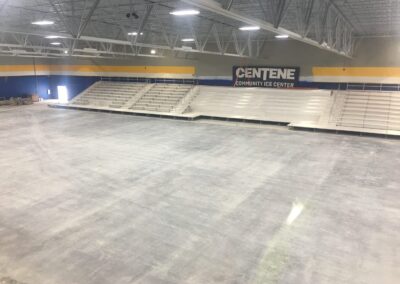By Mike Miller
St. Louis, MO
Twitter: @MikeMillerSTL
There was talk of installing a countdown clock, something to alert those working inside the St. Louis Legacy Ice Foundation’s office of the milestone that is fast approaching.
That conversation, however, didn’t extend very far.
“We decided that it would actually make us more anxious than excited to have the countdown clock going,” St. Louis Legacy Ice Foundation chairman Patrick Quinn said, “given what Mother Nature has done to us over the last 14 months.”
Besides, after years of angling for support, overseeing plans and spearheading efforts to bring a new multi-sheet iceplex to the area, Quinn and others involved with the construction of the Centene Community Ice Center need no reminders that their project is nearing completion.
Merely a month remains before the Sept. 7 grand opening of the St. Louis Blues’ new practice facility in Maryland Heights, a sprawling, state-of-the-art complex tailored to the needs of the Stanley Cup champions and an ever-growing local hockey community eager for a new center circle.
The $78 million project — funded through a public-private partnership with support from the City of Maryland Heights, St. Louis County and the state of Missouri — is entering its final stages ahead of the Blues’ training camp next month. With the shell of the structure long complete, crews are continuing to assemble some of the hockey-specific areas of the building, while making initial preparations for the first sheets of ice on each of the three indoor rinks.
“There’s a lot going on,” Quinn said. “Early in construction projects, it’s hard to see progress happening. We’re in that phase now where every 24 hours it literally feels and looks as if you haven’t been there in a week.”
A major checkpoint in the building effort was reached last month, when the core foundations for all three indoor sheets of ice were installed. Because there is a 30-day cure period before ice can be chilled on a new configuration, Quinn said crews worked on a hard deadline of July 15 to complete the functioning innards of the event floors for each rink, hitting that target date without issue.
Now, the bells and whistles are coming into focus.
Dasher boards are currently being installed in each of the rinks. Plexiglass will soon follow. Then, in short order, crews will turn on the compressors that will chill the floors and create an environment conducive to quality ice.
“At the end of the month, we can begin to bring the ice up on the three sheets, one at a time,” Quinn said. “Those are big milestone pieces that everything has been set up towards. Around the rinks, we have some seating to get finished, and then all of the common areas and amenities for our guests in the form of the restaurant, our grab-and-go station, concession stands and restrooms and public facilities. We’re getting all the ‘I’s’ dotted and the ‘T’s’ crossed.”
Those detailing efforts also include the upcoming installation of a four-panel video board inside of the 2,500-seat main rink.
“After almost four years of being after this for our community and trying to bring this thing home, I think that’s going to be one of the most gratifying things for me,” Quinn said. “That will really signal that, hey, this is something we’ve never had in a rink in this town, other than Enterprise Center. We’ve not had something proper like this to really give us the full effect of an ice arena. I think that will be an element that screams to all of us that are walking in there that, holy smokes, this place is for real.”
And while much of the planning is geared toward the building’s primary tenants, the Blues won’t be the only squad to settle in during the coming weeks. With four ice surfaces in total, including a covered outdoor rink, the complex will also house teams from Lindenwood University’s hockey program, the St. Louis AAA Blues, the St. Louis Lady Cyclones and the Blues Alumni Association, along with several area youth programs.
It’s a major league facility with multi-purpose capabilities, perhaps most visible in the versatility of the outdoor pavilion area. During the spring and summer, the outdoor rink can be converted into a live music venue with a capacity of more than 4,000.
“We made something that’s great for hockey, but we also gave the community amenities here that we wouldn’t have otherwise had in that area of St. Louis County, or anywhere in the community to host these kinds of events,” Quinn said. “It’ll help put us on the map to grab some concerts that we’re not getting today because we just don’t have a venue at that price point for folks to come to.
“It’s really about making this thing fly for the entire year. That’s one of the big elements. In order to reduce and settle and pay off all the bonds, you have to be able to generate revenue everywhere you can in the facility. Having this rink that otherwise would not be viable after you get past March and turning it into a revenue producing space for a large chunk of the year shows the ingenuity of the group. It also gives the community a piece that says, ‘Wow, here are more events, more things we could be doing to help us have some fun.’”
For Quinn and others involved in the planning and construction of the Centene Community Ice Center, the fun is only a month away.
And they don’t need a countdown clock to remind them.
“Everybody is just digging deep here when they couldn’t thrown their hands up in the air with all the weather delays that we’ve had,” Quinn said. “It’s folks saying, ‘Hey, we need to be ready for the Stanley Cup champions. We need to get ready for all these kids out in the community who need more ice to get after playing this great game.”




